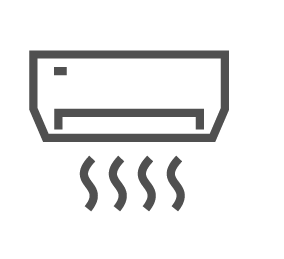This Halloween we are highlighting the top 10 scariest things restaurants do to waste energy. Restaurant energy consumption being higher than most other commercial sources it is essential we try to share best practices to decrease the high amount of consumption. Restauranteurs and franchisees consistently are fighting to keep their expenses low and profits high, with energy consumption always being viewed as a non-controllable we’ve complied ways to control that expense. In the fight to conserve energy and save our environment, there is never one person nor one industry at fault so embracing technology and IoT to combat this is crucial.
HVAC and/or fans running 24/7 even when the building is not occupied
This practice is something we see all of the time. Frequently we will show up to an empty building to install with only a manager or two occupying the building, and the system is still running as if the building was occupied during business hours. A simple automation schedule on a programmable thermostat will decrease this culprit of restaurant energy consumption.
Running HVAC units when they aren’t producing cold/hot air
Having a building automation system or energy management system that gives you visibility into your facility could make all the difference here. In our home when our AC breaks its pretty evident because we only have one or 2 cooling a small space. In restaurants, it’s much harder to tell if an AC unit isn’t running because you have so many other units running alongside it. Many times its difficult to feel the temperature change because the other units are working harder to compensate for the unit that is down. This wastes a ton of energy because the units that are compensating rarely shut off, running extended hours and reducing the equipment life.
Leaving the exterior lighting on during the day
This is not just a restaurant energy waster but a common pain point with restaurant owners and franchisees all over the country. A familiar narrative among our clients was their concern for wasted energy when they would pull up to a location at noon, and the exterior lighting was still on. Employees that arrive before the sun is up turn on the lights and often forget to turn them back off once the sun rises. This wastes a large amount of energy at a single location alone, let alone multiplied across several locations in a portfolio. A simple astronomical clock that interacts with the interior and exterior lighting is an easy fix for this.
Preventative maintenance techs doing unnecessary repairs without solving the real issue
This is a not so common occurrence but it still happens. Most restaurants have a company that takes care of all of the restaurants under that corporate umbrella. Sometimes there are technicians that don’t actually complete the work that they are paid to do. We have seen cases when an AC unit was not functioning and a restaurants preventative maintenance company was called out and were asked if the AC filters were blocked. The company verified that a tech had been out earlier that week and replaced the air filter and no action was needed. A tech from a different company was called out and found that the air filters were completely blocked with dirt and dust, not allowing any air to pass through. This made the unit run nearly 24 hours a day, once the filter was replaced the runtime was cut by 75%!
Room sensors by supply vents or heat source in kitchen, causing the unit to cycle on and off too quickly.
Placing sensors in these areas can lead to huge problems in the future. The purpose of a room sensor for an air conditioning unit is to give an accurate reading of the temperature of that space. If sensors are placed too close to a heat source, like an oven, this causes the sensor readings to be hotter than usual and causes the unit to turn on more frequently than needed. This is a huge contributor to restaurant energy waste and the degradation of the air conditioners life.
Other building areas sensors not being hooked up and controlling temperatures based on office temperature
We touched on how sensors for air conditioners work and this is one thing we see often and is not necessarily the fault of the restaurant but the company they hire to manage their cooling equipment. For a large space, like a restaurant, there are supposed to be multiple sensors for each area; for example the dining area, the kitchen, the lobby, etc. These sensors dictate how hot or cold an area will be, having multiple sensors allows the space to have a consistent temperature throughout. Having one sensor placed in a back office, well there are just a few problems with that. The offices are typically small so cooling an area that small will take no time at all, meanwhile, your customers may be suffering from heat stroke while they try to enjoy their hamburger.
Temperature display outside of walk-in reading incorrect temperature causing stored food to fall below expected temperature range.
This particular statement is something that is easily addressed when you install building automation or energy management system. So many times when we connect our system into locations, they are surprised by the visibility and the lack of knowledge they had previously. Having sensors placed inside of refrigerated areas that communicate information back to a dashboard is the most powerful kind of visibility. You get real-time and retrospective temperatures, but the best part is the power of alarming. You can be notified via text or email when temperatures rise above or go below certain set-points, saving you money in lost inventory and giving you peace of mind knowing your food is safe always.
Employees dictating the temperature of the entire restaurant
How many times have you walked into a restaurant and it is freezing cold? Cold to the point where you can barely enjoy your food because of the teeth chatter and shakes you are suffering? This most likely happens because the employees in the back are setting the temperature for the entire restaurant. They are up and down, moving around, cooking food, and working hard. They are naturally going to be hotter than someone who has just walked in from outside to enjoy a meal. That means while the employees are comfortable the guests are not, and is costing you money in wasted energy consumption.
Propping walk-in freezer/cooler doors open
If you have ever worked in a restaurant, you know that deliveries come and the doors get propped open to receive food. That is the most efficient way to do this, but it is the most inefficient, energy speaking, as well. All of that cold air that is keeping the fresh food inside has escaped and now the compressor turns on. The door is open, and the compressor is on, now the compressor stays on because it is trying to cool an area the size of the kitchen rather than a walk-in size freezer.
Placing hot food in the walk-in cooler/ freezer
Makes the refrigerator work extra hard. When hot food is placed in the refrigerator, it raises the temperature of the freezer or cooler and the compressor turns on. Not only does this use extra energy but it also decreases the life of the refrigerator or freezer itself, along with the degradation of the food quality of the other foods by increasing the chances for freezer burn. Letting the food cool off to room temperature first has the potential to save you money, maintain the quality of your food, and elongate the life of your equipment.









